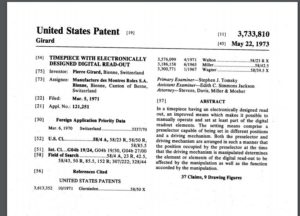Rolex Read the Patent

Rolex Design Patent
Read the Rolex Design patent here.
Notable inventions and patents
Among the company’s innovations are:
- In 1910, the first watchmaker to earn chronometer certification for a wristwatch.
- In 1926, produced a waterproof wristwatch, Rolex Oyster.But it was far from the first company to do (see, for example, the “Submarine Watch” from the First World War, which was made by Tavannes and retailed by Brook & Son in Edinburgh). Wilsdorf even had a specially made Rolex watch (the watch was called the “DeepSea”) attached to the side of Trieste, which went to the bottom of the Mariana Trench. The watch survived and tested as having kept perfect time during its descent and ascent. This was confirmed by a telegram sent to Rolex the following day saying “Am happy to confirm that even at 11,000 metres your watch is as precise as on the surface. Best regards, Jacques Piccard”.
- In 1931, a self-winding Rolex wristwatch was offered to the public (the so-called the “bubbleback” due to the large caseback). However, as with so many alleged Rolex “firsts” it was, in fact, not the first and was preceded to the market by Harwood which patented the design in 1923 and produced the first self-winding watch in 1928. This was powered by an internal mechanism that used the movement of the wearer’s arm. As well as making watch winding unnecessary, it also kept the power from the mainspring more consistent, resulting in more reliable timekeeping.
- In 1945, introduced a wristwatch with an automatically changing date on the dial (Rolex Datejust Ref. 4467). Again, it was not the first company to do so: Mimo made them in the 1930’s — some twenty years earlier.
- In 1953, released the first wristwatch case waterproof to 100 m (330 ft) (Rolex Oyster Perpetual Submariner Ref.6204, 1953)
- In 1954, produced a wristwatch which showed two time zones at once (Rolex GMT Master ref.6542, 1954) Yet again, it was not the first company to do so, as the Longines DualTime preceded the GMT by a full quarter of a century.
- In 1956, made a wristwatch with an automatically changing day and date on the dial (Rolex Day-Date, 1956)
Source (Wikipedia)







